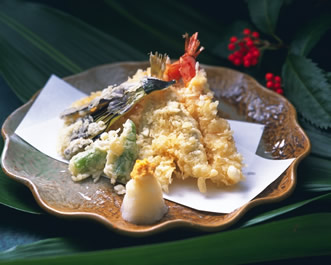Articles on Japan, Links & Reviews
Food in Japan
Tempura
Most Japanese food has a reputation of being very healthy. Here's one which isn't, but who cares because it tastes great! Tempura is essentially any kind of seafood or vegetable that has been dipped in batter and deep-fried. There are many varieties of popular tempura which may be eaten on their own or combined with noodles (soba / udon) or rice (tendon) as a topping. Up-market Japanese restaurants pride themselves on the freshness/seasonality of the filling and the crispiness of the batter, and will often serve small pieces as one of the courses in a lavish meal.
Recommended tempura to try are ebi (prawns), hasu (lotus root), nasu (eggplant), kabocha (pumpkin) and shiso (perilla leaves). My personal favorite though has to be maitake mushrooms, especially if you can get hold of some freshly picked ones which have a much enhanced flavor and texture. Sprinkle a generous amount of sea-salt on top to eat, or dip the tempura in tentsuyu with grated daikon radish. (Tentsuyu is made from mirin, soy sauce and dashi stock.)
The technique of cooking Tempura is believed to first have been introduced to the Japanese by Portuguese traders in Nagasaki around the 16th or 17th Century, although it didn't spread in popularity until the middle of the Edo period (late 18th Century). Around this time permanent tempura stalls sprang up along major thoroughfares, drawing customers by the tempting aromas and easy "drop-by" policy, leading the tempura trade to flourish and prosper. However, towards the end of the Edo period, shortages of eggs and oil made tempura a delicacy of the upper classes, leading to the creation of the style of tempura we see today.
Being one of the representative dishes of Japan, tempura can be found in many restaurants all over the country. Most soba noodle shops will offer tempura, either as a topping or as a separate dish, while some restaurants specialize in only tempura. It is also commonly eaten at home although the difficulty of making a consistently good quality batter has been the bane of mothers and housewives down the ages. Still the technique is similar to making calamari or fish 'n' chips, just remember that thinner vegetables don't need much cooking time, and that eggplants' skin should be scored before cooking to prevent them exploding!
Glossary
Dashi
- A soup/stock used for many bases in Japanese cooking. (Vegetable stock or chicken stock may be substituted depending on the dish)
Ebi
- Prawns or shrimps
Hasu
- lotus root (also called renkon)
Kabocha
- A Japanese pumpkin / squash
Maitake Mushrooms
- Wild mushrooms (Grifola frondosa) known among English speakers as Sheep’s Head mushroom or Hen of the Woods.
Mirin
- A kind of rice wine similar to sake but with slightly lower alcohol content and higher sugar content. (A reasonable substitute is to mix sugar with sherry or sake.)
Nasu
- Eggplant
Shitake Mushrooms
- Large flat mushrooms, with quite powerful flavor
Shiso
- Perilla leaves
Soba
- Thin noodles made from buckwheat, which should have an "al dente" texture.
Tendon
- A dish of Tempura and Donburi, ie a bowl of rice topped with tempura
Udon
- Thick noodles made from wheat-flour.

Tempura
Photo provided by FOODEX JAPAN
Tempura Recipe
(Difficulty Rating: 4 out of 5)Ingredients (serves 4)
- 8 Tiger Prawns (shelled and deveined, but with tails intact)
- *Maitake Mushrooms (2 packs)
- 1/4 Pumpkin (cut into slices)
- 2 Eggplants (sliced)
- 2 Bell Peppers (quartered)
- **Small lotus root (sliced)
- 1 egg, lightly beaten
- 200ml cold water
- 75g cornflour
- 75g flour
- 1 cup dashi stock (or vegetable stock)
- 1/4 cup mirin (or sweet sake/sherry)
- 1/4 cup soy sauce
- 1 cup grated raddish (preferably daikon)
- Pinch of grated ginger
Batter
Dip (optional - otherwise just sprinkle with salt)
Instructions
- Prepare vegetables and prawns
- Make dip by combining ingredients and pouring into individual dipping bowls
- Make batter - in a bowl combine egg, flours and water and mix to create slightly lumpy batter
- Heat vegetable oil in deep fryer (about 180 deg C)
- Dip prawns and vegetables in batter, making sure they are fully coated
- Fry prawns and harder vegetables first, in batches until browned, followed by lighter vegetables
- Drain on kitchen roll
- Serve and eat immediately
In addition to Japan's Premier Shop Directory, English OK! offers the following services:
Customer Service English Training: Onsite Workshops, e-Learning & Books
Multilingual Website Design
